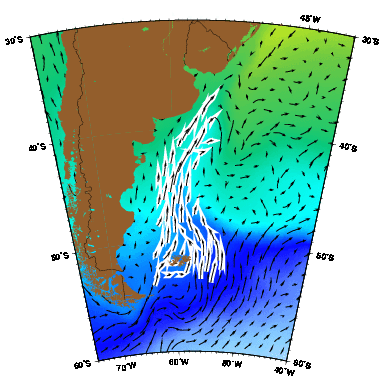
| ||
| The Malvinas current as represented by the Mariano Global Surface Velocity Analysis (MGSVA). It is the northward flow component of the S. Atlantic subpolar gyre. The Malvinas current transports cold water along the coast of S. America and this water mixes with warmer waters of the Brazil current in an region known as the Brazil-Malvinas confluence. Click here for example plots of seasonal averages. | ||
Based on hydrographic data, it is believed that the Malvinas Current has a strong barotropic component and that it is well-mixed (Peterson and Stramma 1991, Vivier and Provost 1999a). It is also thought that the current has significant non-zero bottom velocities, a claim that was directly verified by Harkema and Weatherly (1989, as cited in Garzoli 1993). Their bottom current meters measured velocities of up to 10 cm s-1 (Garzoli 1993). Both of these factors must be taken into account when calculating values of transport by using a reference level of no motion.
Estimates of the volume transport of the Malvinas Current vary widely in the literature, depending on the reference level that is chosen (Garzoli 1993). For example, using a reference level of 1000 m at 38°S, Garzoli (1993) obtained a transport of about 24 Sv. Using a reference level of 1400 m at 42°S and 46°S, Gordon and Greengrove (1986) obtained values of 10 Sv at both locations, although they believed that this value represented the lower limit of the real flow. Piola and Bianchi (1990 as cited in Garzoli 1993), using 1000 m as the reference, found 10-12 Sv. With a reference level of 3000 m at 42°S, Peterson (1992) found 60 Sv in the first 2000 m and 75 Sv in total, while at 46°S he found 70 Sv in the first 2000 m and 88 Sv in total. Choosing the bottom as their reference level at 45°S, Saunders and King (1995) calculated 50 Sv in the thermocline and 60 Sv in total (Maamaatuaiahutapu et al. 1998). Vigan et al. (2000) noticed that the transport values decreased from south to north. In particular, observations between 40°S and 38°S plummeted from about 20 ±5 Sv to zero. They attribute this to the fact that the Malvinas Current returns to the south at these latitudes. Thus, the location of the observations, relative to the location and orientation of both the high-velocity core of the Malvinas Current and its return flow, may also account for some of the variability in transport estimates.
Direct measurements of the velocity of the Malvinas Current are scarce. According to Peterson (1992), surface drifters in the Malvinas Current travel at about 40 cm s-1. Garzoli (1993) found geostrophic velocity values of 102 cm s-1 at 36.5°S and -61 to -62 cm s-1 at 36.6°S that were associated with the northward-flowing Malvinas Current and the southward return flow, respectively. The along-shelf flow of the Malvinas Current is highly variable from year to year, and it does not appear to have an annual or even a semi-annual cycle. However, there is a suggestion of significant energy at periods of about 135 days (Vivier and Provost 1999a, 1999b). On the other hand, the cross-shelf flow (perpendicular to the coast) clearly shows an annual cycle that is associated with the position of the subantarcitc front (Vivier and Provost 1999a).